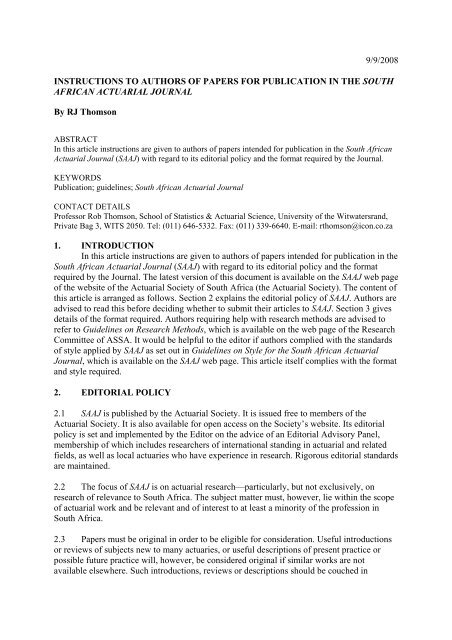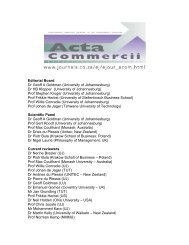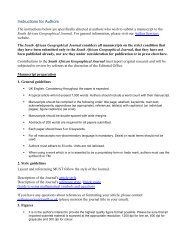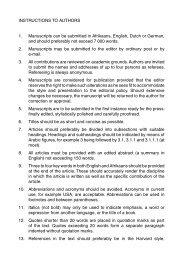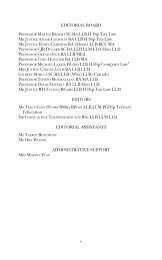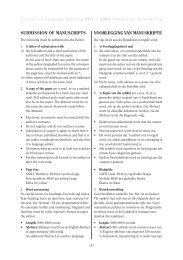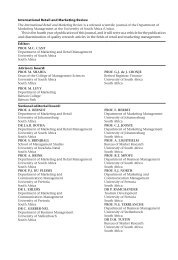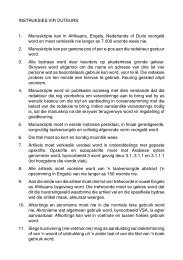INSTRUCTIONS TO AUTHORS OF PAPERS
INSTRUCTIONS TO AUTHORS OF PAPERS
INSTRUCTIONS TO AUTHORS OF PAPERS
Create successful ePaper yourself
Turn your PDF publications into a flip-book with our unique Google optimized e-Paper software.
9/9/2008<br />
<strong>INSTRUCTIONS</strong> <strong>TO</strong> <strong>AUTHORS</strong> <strong>OF</strong> <strong>PAPERS</strong> FOR PUBLICATION IN THE SOUTH<br />
AFRICAN ACTUARIAL JOURNAL<br />
By RJ Thomson<br />
ABSTRACT<br />
In this article instructions are given to authors of papers intended for publication in the South African<br />
Actuarial Journal (SAAJ) with regard to its editorial policy and the format required by the Journal.<br />
KEYWORDS<br />
Publication; guidelines; South African Actuarial Journal<br />
CONTACT DETAILS<br />
Professor Rob Thomson, School of Statistics & Actuarial Science, University of the Witwatersrand,<br />
Private Bag 3, WITS 2050. Tel: (011) 646-5332. Fax: (011) 339-6640. E-mail: rthomson@icon.co.za<br />
1. INTRODUCTION<br />
In this article instructions are given to authors of papers intended for publication in the<br />
South African Actuarial Journal (SAAJ) with regard to its editorial policy and the format<br />
required by the Journal. The latest version of this document is available on the SAAJ web page<br />
of the website of the Actuarial Society of South Africa (the Actuarial Society). The content of<br />
this article is arranged as follows. Section 2 explains the editorial policy of SAAJ. Authors are<br />
advised to read this before deciding whether to submit their articles to SAAJ. Section 3 gives<br />
details of the format required. Authors requiring help with research methods are advised to<br />
refer to Guidelines on Research Methods, which is available on the web page of the Research<br />
Committee of ASSA. It would be helpful to the editor if authors complied with the standards<br />
of style applied by SAAJ as set out in Guidelines on Style for the South African Actuarial<br />
Journal, which is available on the SAAJ web page. This article itself complies with the format<br />
and style required.<br />
2. EDI<strong>TO</strong>RIAL POLICY<br />
2.1 SAAJ is published by the Actuarial Society. It is issued free to members of the<br />
Actuarial Society. It is also available for open access on the Society’s website. Its editorial<br />
policy is set and implemented by the Editor on the advice of an Editorial Advisory Panel,<br />
membership of which includes researchers of international standing in actuarial and related<br />
fields, as well as local actuaries who have experience in research. Rigorous editorial standards<br />
are maintained.<br />
2.2 The focus of SAAJ is on actuarial research—particularly, but not exclusively, on<br />
research of relevance to South Africa. The subject matter must, however, lie within the scope<br />
of actuarial work and be relevant and of interest to at least a minority of the profession in<br />
South Africa.<br />
2.3 Papers must be original in order to be eligible for consideration. Useful introductions<br />
or reviews of subjects new to many actuaries, or useful descriptions of present practice or<br />
possible future practice will, however, be considered original if similar works are not<br />
available elsewhere. Such introductions, reviews or descriptions should be couched in
language accessible to actuaries. The publication of a paper in the transactions of a conference<br />
or in an unrefereed periodical, or the distribution of a paper by the authors, will not generally<br />
preclude it from being considered as an original paper. If, however, any part of a paper<br />
submitted for publication has been published or distributed in any manner, this should be<br />
drawn to the attention of the Editor.<br />
2.4 The authors of a paper submitted for publication in SAAJ must declare in that paper<br />
any interest they may have in the outcome of the research. If, in the opinion of the Editor, any<br />
such interest might have materially affected the outcome of the research in a manner that he<br />
or she considers inappropriate, or may appear to have so affected it, the Editor may decline<br />
publication of the paper. If the Editor becomes aware of such an undisclosed interest and the<br />
author refuses to disclose it, the Editor will decline publication of the paper.<br />
2.5 In general, papers should be no longer than about 40 pages in SAAJ (about 16 000<br />
words). Longer papers will be considered, but may have to be shortened, or to be restructured<br />
into two or more parts if they are otherwise suitable. Authors are advised to contact the Editor<br />
in advance if they suspect that their papers will exceed these limits.<br />
2.6 It is the responsibility of the authors of a paper to clear copyright matters with the<br />
relevant parties. Immediately on the date of acceptance for publication by SAAJ, a paper<br />
becomes the copyright of ASSA.<br />
2.7 Papers may be submitted in English, or in Afrikaans with an English translation of the<br />
abstract. Authors are advised, however, that if it is not possible to find Afrikaans-speaking<br />
scrutineers who are sufficiently conversant with the subject of their papers, it may be<br />
necessary to refer the paper back to the authors for translation into English.<br />
2.8 A paper may be submitted to the Editor by any author or group of authors, regardless<br />
of whether they are members of ASSA. All papers are scrutinised by at least two scrutineers<br />
nominated by the Editorial Advisory Panel or selected by the Editor. The names of the<br />
scrutineers are not disclosed to the authors unless a scrutineer wishes to be known.<br />
Scrutineers will not enter into any correspondence or discussion with the authors or with other<br />
scrutineers with regard to the paper except via the Editor. Authors are advised not to nominate<br />
scrutineers. On the advice of the scrutineers, the Editor decides whether to accept or reject<br />
each paper, or whether to refer it back to the authors for amendment or revision. It should be<br />
noted that acceptance without amendment is relatively unlikely. The decision of the Editor is<br />
final. At the discretion of the Editor, articles other than refereed papers may be published:<br />
such articles are indicated accordingly.<br />
2.9 Authors should not rely on the scrutineers to check the accuracy of any numerical<br />
calculations whose results are shown in the paper. Notwithstanding any alterations made on<br />
the recommendations of scrutineers or the Editor, authors remain solely responsible for the<br />
accuracy of the contents of their papers.<br />
2.10 Authors should be advised within three months of receipt of a paper by the Editor<br />
whether it is accepted for publication and if so what amendments or revision are required.<br />
However, it is sometimes difficult to find appropriate scrutineers and, although scrutineers are<br />
asked to make their comments within at most two months, it is not always possible for them<br />
to do so. When a revised version of the paper is received by the Editor, copies of this will be<br />
sent to the scrutineers and the process is repeated.
2.11 When the authors receive a report from the scrutineers, they should ensure that each of<br />
the scrutineer’s comments is attended to. If it is not obvious how the authors have amended<br />
the paper in response to a particular comment made by a scrutineer, they should explain their<br />
amendments in a covering note to the Editor. The authors may defend the paper against<br />
comments made by a scrutineer. However, it is recommended that any such defence should<br />
generally be made in the paper rather than in a note to the Editor. This may entail explaining<br />
both the criticism and the defence in the paper. Such defences will generally enhance the<br />
quality of the paper. It should be borne in mind that the scrutineers have been chosen as being<br />
particularly well versed in the subject of the paper. If they appear to have misunderstood<br />
something in the paper, it is quite likely that other readers will do so too. Care should<br />
therefore be taken to avoid such misunderstandings by suitable amendment of the paper.<br />
Authors should not make substantial or extensive amendments to the paper other than those<br />
required by the scrutineers or the Editor. If any criticism is unclear, the authors should query<br />
it with the Editor before resubmitting the paper.<br />
2.12 After acceptance the authors see one set of proofs for checking, subject to a deadline<br />
indicated by the Editor. Authors who are not members of ASSA will each receive one copy of<br />
the issue in which their article is published.<br />
2.13 Authors of papers read at conventions or sessional meetings of the Actuarial Society<br />
of South Africa are invited to submit them (after amendment, if necessary to conform to these<br />
instructions and to the Guidelines on Style) for publication in the Journal. A reader who<br />
wishes to respond to such a paper may inform the Editor accordingly. Once a paper has been<br />
accepted for publication in the Journal, the title, authors’ names and abstract are placed on the<br />
Journal’s web page. If a reader wishes to read such a paper with a view to responding to it, he<br />
or she may inform the Editor accordingly. Unless specifically requested by the respondents,<br />
responses to a paper will not themselves be refereed, but the authors of the original paper will<br />
have the right to reply in the same issue. In order to avoid delays in the publication of the<br />
Journal, it may be necessary to apply time constraints to readers’ responses and authors’ rights<br />
to reply. Publication of responses to papers will in any case be at the discretion of the Editor<br />
on the advice of the Editorial Advisory Panel.<br />
2.14 Besides peer-reviewed articles, the Journal may include:<br />
− an editorial;<br />
− letters to the Editor;<br />
− abstracts of recent research reports, dissertations and theses for postgraduate<br />
degrees at South African universities;<br />
− abstracts of monographs;<br />
− abstracts of articles of interest to actuaries in other South African journals;<br />
− abstracts of publications on South Africa, including articles in other journals<br />
and chapters in books, that may be of interest to actuaries elsewhere; and<br />
− book reviews.<br />
2.15 Copies of forthcoming issues may be ordered from ASSA at PO Box 4464, Cape<br />
Town 8000. Limited numbers of copies will also be retained by ASSA for subsequent sale.<br />
All correspondence with regard to editorial policy and the publication of papers should be<br />
addressed to the Editor, Rob Thomson, whose contact details appear at the start of this article.<br />
3. FORMAT
3.1 GENERAL REMARKS<br />
3.1.1 This section gives guidance on format to authors, or to their secretaries, who<br />
are preparing papers for publication in SAAJ. If they are followed, then the printing process<br />
will be made much easier. This document is laid out in the format that should be followed.<br />
Authors are not required to conform in detail to this format, except as described in this<br />
section; the format is applied during the publication process. In particular, conventions with<br />
regard to line spaces and indenting, and variations between bold and plain typefaces, need not<br />
be adhered to by authors. Authors are requested to avoid the use of unnecessary formatting<br />
information. In particular, indenting should be applied by means of tabs, not multiple spaces.<br />
Only one space is used between sentences.<br />
3.1.2 It is assumed that authors will prepare text using a word-processing system on<br />
a computer, and are able to submit the text on a diskette. The publication system can read<br />
diskettes prepared by several different word-processing systems, so it is convenient if the text<br />
is laid out in the required format. This document has been prepared on MS Word 97, in the<br />
format required for SAAJ. If the author wishes to prepare text on a system that may not be<br />
readable by the Editor, this should be discussed with the Editor before submission.<br />
3.1.3 Text is prepared on A4 paper, as this is, although it is altered by the publishing<br />
system to fit on the A5 size of SAAJ. This document uses the Times New Roman font with a<br />
normal font size of 12 point, with single line spacing. Italics should be avoided except to<br />
denote foreign words normally italicised in English usage or titles of publications.<br />
3.1.4 Arrangements can be made for the editing of the format of a paper by the<br />
layout editor of SAAJ to conform to the requirements of SAAJ before it is submitted. The<br />
contact details of the layout editor may be obtained from the Editor. It should be noted,<br />
however, that any such arrangements are to be made between the authors and the layout<br />
editor, that the costs will be borne by the authors and that ASSA will not be involved.<br />
3.2 LAYOUT<br />
3.2.1 INTRODUCTION<br />
Each paper begins with:<br />
– title;<br />
– authors’ names;<br />
– presented at (if applicable);<br />
– abstract;<br />
– keyword;<br />
– contact details; and<br />
– quotation (if desired).<br />
These are laid out as shown at the top of this document, and as described below.<br />
3.2.2 TITLE <strong>OF</strong> THE PAPER<br />
The title should not include abbreviations.<br />
3.2.3 <strong>AUTHORS</strong>’ NAMES<br />
3.2.3.1 The sequence is: initials; surname. No qualifications are given. There are no<br />
spaces or points between initials.<br />
3.2.3.3 The order of authors’ names is up to the authors themselves. Readers may<br />
interpret the ordering, particularly if it is non-alphabetic, to reflect the relative contributions of<br />
the respective authors.
3.2.4 ABSTRACT<br />
3.2.4.1 Every paper requires an abstract; this should be a summary of the paper, in one<br />
long or two or three short paragraphs. The abstract is often copied by other journals that print<br />
lists of papers with abstracts, so it should be written in a way that will encourage others to<br />
read the paper. It is preceded by the word ‘ABSTRACT’.<br />
3.2.4.2 Only paragraphs after the first are indented.<br />
3.2.5 KEYWORDS<br />
3.2.5.1 Next come keywords; these are also used by other journals and in citation<br />
indices, so choose words that give an indication of what is of interest in the paper. Choose<br />
normally not more than about five keywords. The list of keywords is preceded by the word<br />
‘KEYWORDS’.<br />
3.2.5.2 The keywords themselves are not indented. Only the first has an initial capital<br />
letter. They are separated by semi-colons (;) followed by one space. There is no point (.) after<br />
the last keyword.<br />
3.2.6 CONTACT DETAILS<br />
The author’s contact details (or if there are more than one, those of one of the authors) are<br />
shown under the heading ‘CONTACT DETAILS’. The details to be given are: title, given<br />
name, surname, postal address (including country if not in South Africa), all separated by<br />
commas, followed by ‘; Tel:’, the telephone number preceded by the country code if not in<br />
South Africa and the area code; ‘; Fax:’, the fax number similarly stated; ‘E-mail:’ and the e-<br />
mail address.<br />
3.2.7 QUOTATION<br />
Some authors like to include a quotation at the start of their papers. This is acceptable. If it is<br />
done, the quotation comes next, followed by the name of the author and possibly the source of<br />
the quotation. There is no point (.) at the end.<br />
3.3 THE MAIN TEXT<br />
3.3.1 The main text of the paper comes next. This is always separated into sections,<br />
numbered 1, 2 etc. Each section may be subdivided into subsections, numbered 1.1, 1.2 etc.,<br />
and these in turn may be subdivided into sub-subsections, numbered 1.1.1, 1.1.2 etc. Finally<br />
there are paragraphs, which may be numbered 1.1, 1.2 etc. or 1.1.1, 1.1.2 etc., or 1.1.1.1,<br />
1.1.1.2 etc., depending on the level of subsections needed. Never go beyond four levels of<br />
numbering.<br />
3.3.2 Even if the author’s word-processor is able to number paragraphs<br />
automatically, such features should not be used.<br />
3.3.3 A section is headed with the section number (e.g. 1), followed by a point (.),<br />
then a tab space, then the title of the section, in full capitals.<br />
3.3.4 A subsection starts with its number (e.g. 1.1), followed by a tab space (no<br />
point), then the subsection title, in full capitals.<br />
3.3.5 A sub-subsection starts with its number (e.g. 1.1.1), followed by a tab space<br />
(no point), then the sub-subsection title, with capitals for the initial letters of important words.<br />
3.3.6 A paragraph under a major section heading starts with its number (e.g. 1.1),<br />
followed by one tab space (no point), then the text. A paragraph in a subsection or subsubsection<br />
is indented one tab space, then starts with its number (e.g. 1.2.3 or 1.2.3.4 as<br />
appropriate), followed by one tab space (no point), then the text. Avoid using a new paragraph<br />
for each sentence, except where appropriate.<br />
3.3.7 If a section contains only one paragraph, that paragraph does not need a
number.<br />
3.3.8 There is often a need to refer to another section or paragraph in the text. In this<br />
case refer to sections, subsections and sub-subsections all as, e.g. ‘section 1’, ‘section 2.1’ or<br />
‘sections 3.2.1 and 3.2.2’; refer to paragraphs as, e.g. 4.1, 4.2.1 to 4.2.4 etc. Put<br />
‘paragraph’ if you do not have the symbol available.<br />
3.3.9 There should be only one space between sentences, which are separated by a<br />
point (.). Similarly, there should be only one space after a colon (:) or semi-colon (;).<br />
However, do not put any spaces after the last point in a paragraph.<br />
3.3.10 Except for the referencing of unpublished sources (see 3.6.2), footnotes<br />
should not be used. Endnotes should not be used.<br />
3.3.11 Formulae should generally be placed centrally. Exceptions may occur where a<br />
series of equations would be better aligned at the ‘=’ sign, especially where the left-hand side<br />
of the equations is omitted after the first, or where a list of definitions is given in the form of<br />
equations after a centrally placed equation. Formulae referred to in the text should be<br />
numbered in brackets in simple sequence from the start to the end of the paper using a rightjustified<br />
tab to the right of the formulae. Formulae not referred to in the text should not be<br />
numbered.<br />
3.3.12 The use of italics or bold typeface for emphasis should be avoided.<br />
3.4 POINTS<br />
3.4.1 Sometimes items are best set out as a series of points. These can be introduced<br />
with (1), (2) etc., with (a), (b) etc, or with a series of dashes (–) (but not with ‘bullets’ (•)). In<br />
each case they are fully justified to the left margin, i.e. not indented, unless dashed points<br />
come within a lettered point, in which case they should be indented one tab space. The text<br />
within a point should be indented and aligned. See 3.2.1.<br />
3.4.2 A list of points should be introduced with a colon (:) at the end of the<br />
preceding line. If the text in each point is short, each should start with a small letter, and<br />
should end with a semi-colon (;), except the last, which should end with a point (.), and the<br />
second-last, which should end with ‘; and’. Each point should be grammatically consistent<br />
with the introduction, and grammatically parallel to the other points, so that the whole reads<br />
as one sentence. Points should not commence with capital letters unless they are sentences. If<br />
the text in each point is longer, amounting to one or more sentences, then each should start<br />
with a capital and end with a point, and should be structured as a complete sentence. A blank<br />
line should be inserted at the end of a list of points.<br />
3.5 ACKNOWLEDGEMENTS<br />
Some authors like to include acknowledgements to those who have helped them in the<br />
development of their paper. This should appear at the end of the main text, introduced by the<br />
word ‘ACKNOWLEDGEMENTS’. They should not be too fulsome.<br />
3.6 REFERENCES<br />
3.6.1 All work done by other authors and used or referred to in the text should be<br />
attributed to the authors and every statement obtained from another source should be properly<br />
cited. No statement that has already been made by another author should be made in the text<br />
without citing that author. The purposes of these requirements are to avoid plagiarism, to<br />
establish the authority of the statements made and to avoid covering ground that has already<br />
been covered in the literature. (Every statement made must have some source of authority,<br />
which should be clear to the reader. The authority may be from observed data, from logical<br />
argument or from the literature.) An exception to these requirements is knowledge that is<br />
fundamental to actuarial science or to secondary education. If an entire section is based on a
particular author’s work, this should be made clear. Where it is appropriate to quote the actual<br />
words of another author, they should be shown accordingly (see 4.2 of Guidelines on Style).<br />
Extensive quotations may require permission from the authors concerned; this is the<br />
responsibility of the authors of the paper.<br />
3.6.2 A document, whether printed or retrieved from the internet, should be treated<br />
as published literature if and only if:<br />
(a) it has been published (i.e. been made available to the public, either at<br />
reasonable cost or free of charge) by a stated publisher other than the author;<br />
and<br />
(b) the year in which it was published is stated by the publisher; and<br />
(c) (i) it is published in a peer-reviewed journal; or<br />
(ii) it is published by an authoritative publishing house; or<br />
(iii) there is other reason to consider it authoritative.<br />
3.6.3 A document that has been accepted for publication as published literature may<br />
be cited as such. An article submitted for publication but not yet accepted should be treated as<br />
unpublished. A document should be listed in the references if and only if it is cited as a source<br />
of authority. The listing of references is explained in 3.6.7–14 below. If a document is cited<br />
merely as a source of information, particularly in the case of a document that is not published<br />
in a peer-reviewed journal or by an authoritative publishing house, it should be cited merely<br />
by means of a footnote; it is recommended that the word-processor’s footnote system be used<br />
for this purpose. Where possible, published works should be cited in preference to<br />
unpublished works. A statute should be referred to as, e.g., ‘the Pension Funds Act, 1956 1 ’<br />
with a footnote.<br />
3.6.4 In the text, except where the citation itself is in parentheses, it should be in the<br />
form: ‘Smith (1995)’ or, if it is an unpublished document, ‘Brown (unpublished)’ or, if it has<br />
been accepted for publication: ‘Malan (forthcoming)’. If there are two authors, their names<br />
are joined by ‘&’, not ‘and’, e.g. ‘Van der Merwe & Nkomo (1996)’. If there are three authors<br />
put e.g. ‘Smith, Van der Merwe & Nkomo (1997)’. If there are more than three, put e.g.<br />
‘Smith et al. (1998)’. If you refer to more than one paper by one author with the same year, or<br />
unpublished or forthcoming, put e.g. ‘Smith (1998a)’, ‘Smith (1998b)’ etc. or ‘Brown<br />
(unpublished a)’, Brown ‘(unpublished b)’ etc.. If the citation itself is in parentheses, put e.g.<br />
‘(Smith, 1995)’. Such a citation may be used after a sentence or at the end of a paragraph that<br />
is attributed to the author concerned. If you need to refer frequently to the same work and the<br />
citation is lengthy, put e.g. ‘Smith, Van der Merwe & Nkomo (1997) (referred to as SVN)’,<br />
and refer to it thereafter as ‘SVN’. Instead of referring in full to the work last cited, ‘ibid.’<br />
may be inserted in brackets. Instead of inserting the date in a work already cited, ‘op. cit.’<br />
may be substituted, e.g. ‘Smith (op. cit.)’ or ‘(Smith, op. cit.)’ provided there is no possibility<br />
of confusion. Citations in the text are taken as referring to the authors, and not to the work,<br />
unless the context implies otherwise. Personal pronouns referring to them should be chosen<br />
accordingly, and where there is more than one author, verbs following them should be in the<br />
plural. Citations such as ‘Smith’s (1995) model’ may also be used.<br />
3.6.5 In the citation, reference may be made to the pages referred to by showing<br />
them after a colon within the bracket, e.g. Smith (1998: 276–78) or (Smith, 1998: 276–78).<br />
3.6.6 All citations to the literature in the text of the paper (including appendices)<br />
should be listed as references at the end of the main text, but before appendices. This list is<br />
not intended to be a bibliography of sources that the authors have consulted, nor of sources<br />
that the reader might wish to consult; works not cited in the text should not be listed here.<br />
1 Act no. 24 of 1956 as amended, Republic of South Africa
References are placed in alphabetical order by author, and by date order for any one author.<br />
3.6.7 The list of references should be headed by the word ‘REFERENCES’.<br />
3.6.8 Each reference should be given in the required format. Each begins with the<br />
surname of the author, followed by a comma and a space, followed by initials (not full<br />
forenames), with no spaces or points between. If there is more than one name, each is put in<br />
the same form, with ‘&’ between the last two, and a comma between earlier names. Put all the<br />
names, however many there are. Some publications do not have an obvious author; in that<br />
case the name of a committee or government department will do, but it should be the same<br />
name as used in the main text.<br />
3.6.9 After the authors’ names comes the year of publication, in full, in parentheses,<br />
e.g. ‘(1999)’ or, in the case of a forthcoming or unpublished article, ‘(forthcoming)’ or<br />
‘(unpublished)’. The year etc. may be followed by a small letter to distinguish works by the<br />
same author in the same year, e.g. ‘(1998a)’, ‘(1998b)’, ‘(unpublished a)’ etc. The closing<br />
parenthesis is followed by a point and a space.<br />
3.6.10 Next comes the title of the work referred to. The style of this depends on what<br />
it is. If it is a book, the title is put in italics, with initial capitals for important words, and this<br />
is followed by a point and one space. After this come the name of the publisher, a comma, and<br />
the town of publication, in roman type.<br />
3.6.11 If the work referred to is an article in a journal, the title of the article is in<br />
roman type, with initial capitals only for the first word, followed by a point and one space.<br />
Then comes the name of the journal in which it appears, spelled out in full, in italics and in<br />
title case. The name of the journal is followed by a space, then the volume number, then<br />
another comma and a space, then the first page number. Include the last page number too<br />
(excluding leading digits corresponding to those of the first), with an en-dash (–) separating<br />
the numbers.<br />
3.6.12 For an unpublished work, the title is printed in regular (not italic) font. For a<br />
thesis or dissertation, the details should be shown as e.g. ‘Unpublished PhD thesis,<br />
Department of Actuarial Science, University of ….’ If a year of authorship is indicated, this<br />
should be shown. As indicated above, an article submitted for publication but not yet accepted<br />
should be treated as unpublished; the name of the journal should not be stated.<br />
3.6.13 For a document retrieved from the internet, the format is the same as for a<br />
printed document, except that the name of the publisher should be followed by the uniform<br />
resource locator (URL) of the document in the conventional format. If, however, that URL is<br />
unnecessary or excessively long, the URL of the web page from which the document may be<br />
accessed is sufficient. This is followed by the date on which the information was retrieved,<br />
e.g. ‘retrieved 6/6/2008)’. If the document is also published in hard copy it is not necessary to<br />
show these details.<br />
3.6.14 There are other sorts of references, and they need to be laid out appropriately.<br />
The purpose is to allow the interested reader to find the piece referred to, for example in a<br />
library or on the internet, so enough information must be given for it to be found, but not<br />
more. For illustrative purposes, references of various types are set out in Appendix A in the<br />
format required.<br />
3.7 APPENDICES<br />
Often it is appropriate to put supplementary material, series of tables or figures, data<br />
sources, formulae, proofs etc. into separate appendices. These follow the main text (and after<br />
acknowledgements and the list of references). Appendices are labelled Appendix A, Appendix<br />
B etc. An appendix is treated like a section of the paper; subsections and paragraphs are<br />
labelled, e.g. A.1, A.2.3 etc. Each appendix starts on a new page, and is headed, e.g.<br />
APPENDIX A, in capitals, with the title of the appendix in a similar style below it.
3.8 TABLES<br />
3.8.1 Many papers include tables of various kinds. These may be very short, and are<br />
treated as text tables, holding their normal place in the text. Tables of any larger size should<br />
be numbered and headed, so that they can be moved to an appropriate place in the text.<br />
Normally the printer places them just after the paragraph in which they are first referred to, or<br />
at the next convenient point thereafter, which may be at the top of the next page. A long series<br />
of tables is best put into an appendix.<br />
3.8.2 Tables can be numbered either as Table 1, Table 2 etc, consecutively<br />
throughout the text, or within each section, as e.g. Table 3.1, Table 3.2 etc., within Section 3.<br />
A large table that has to be split into several sections might be numbered e.g. Table 3.1a,<br />
Table 3.1b etc. Tables in appendices should be labelled, e.g. Table C.1, or Table C.1.2.<br />
3.8.3 Tables should generally be introduced, explained and discussed in the text.<br />
Tables are referred to in the text as, e.g. Table 3.1 or Tables 3.1 to 3.6, with an initial capital<br />
T.<br />
3.8.4 A numbered table has a heading, placed above it, that starts e.g. Table 3,<br />
followed by a point, then one space, then the title of the table, with an initial capital, but no<br />
other capitals, and with no final point. It is better if a table can fit vertically on the page (in<br />
portrait style), but a wide table may need to go sideways (in landscape style). For a table that<br />
is to be placed vertically on or within one page, the author may enter it in the document where<br />
it is to appear. The word-processor’s tabling system may be used for this purpose. Otherwise,<br />
the author should show where the table is to be entered by typing, e.g. ‘ENTER TABLE 3.1<br />
ABOUT HERE.’ and the table should be included in a separate file. (A spreadsheet file may<br />
be used for this purpose.) It is not necessary for the author to be concerned about the layout of<br />
tables; this will be seen to during the publishing process. It must be clear, however, which<br />
headings and sub-headings relate to each column or row of entries.<br />
3.8.5 Text in the table should be in 12-point roman type.<br />
3.9 FIGURES<br />
3.9.1 Many papers require figures, diagrams or graphs. These are usually referred to<br />
as ‘figures’. Similar comments apply to figures as to tables. Often figures are graphs, drawn<br />
by means of a graph plotting system. No colour should be used. The author should either<br />
paste figures electronically into the document or show where the figure is to be entered by<br />
typing, e.g. ‘ENTER FIGURE 3.1 ABOUT HERE.’ If the figure is prepared electronically by<br />
means of a standard system, it should be included in a separate file. (A spreadsheet file may<br />
be used for this purpose. A separate file should be used for each figure and unnecessary data<br />
should not be included.) Otherwise, each figure must be submitted in camera-ready form, in<br />
black and white on clean white paper.<br />
3.9.2 A figure should be designed to give the maximum of information with the<br />
minimum of print. A good book on how to design graphs is Tufte (1983). In general, use only<br />
left-hand and bottom axes; make sure that both are appropriately labelled. Use a vertical<br />
logarithmic scale when it is more suitable to do so (e.g. for mortality rates or share prices).<br />
3.9.3 Figures can be numbered either as Figure 1, Figure 2 etc. consecutively<br />
throughout the text, or within each section, as e.g. Figure 4.1, Figure 4.2 etc., within section 4.<br />
Figures in appendices should be labelled, e.g. Figure D.1 or Figure D.1.2, within Appendix D.<br />
3.9.4 Figures should generally be introduced, explained and discussed in the text.<br />
Figures are referred to in the text as, e.g. Figure 4.1, or Figures 5.1 to 5.6, with initial capital<br />
F.<br />
3.9.5 A numbered figure has a caption, placed below it, in Roman type, starting e.g.<br />
Figure 4.1, followed by a point, then one space, then the title of the figure, with an initial
capital, but no other capitals, and with no final point. The caption should be shown with the<br />
figure on the file or sheet of paper used for it.<br />
3.9.6 If a figure is submitted in electronic form, or in hard copy in the size in which<br />
it will appear in publication, text in the figure should be in 12-point roman type. If it is in hard<br />
copy but larger, the typeface used should be proportionately larger, but should still be in<br />
roman type. Figures should not be submitted if they need to be enlarged. The maximum<br />
dimensions of a figure with 12-point type are 118 by 170 mm.<br />
3.10 RUNNING HEADINGS, FOOTERS AND PAGE NUMBERS<br />
Running headings and footers should not be used. The pages should be numbered in<br />
the top right-hand corner using the author’s word-processing system.<br />
3.11 FORM AND DATE <strong>OF</strong> SUBMISSION<br />
The paper should be submitted to the Editor in electronic form either by e-mail or by<br />
post. Subject to alternative arrangements with the Editor, a paper for inclusion in a particular<br />
year’s volume should reach the author by 30 November the previous year.<br />
ACKNOWLEDGEMENTS<br />
The author acknowledges the help of Mrs AD Hart, on whose work section 3 is based. The<br />
contribution of Professor AD Wilkie is also acknowledged.<br />
REFERENCES<br />
Maitland, AJ (2001). An empirical approach to immunization in South Africa, South African Actuarial<br />
Journal 1, 119–38<br />
Tufte, ER (1983). The Visual Display of Quantitative Information. Graphics Press, Cheshire, Conn.
APPENDIX A<br />
HYPOTHETICAL REFERENCES<br />
FOR ILLUSTRATIVE PURPOSES<br />
A set of hypothetical references is set out below for illustrative purposes. This includes:<br />
– unpublished material: Brown (unpublished a), an article on the Internet, Brown<br />
(unpublished b), a paper distributed at a convention of the Actuarial Society, and Brown<br />
(unpublished c), a document distributed by a firm of consultants;<br />
– a paper accepted for publication in a journal: Malan (forthcoming);<br />
– journal articles: Smith (1995a, 1995b) and Smith et al. (1997);<br />
– a dissertation: Smith (unpublished);<br />
– a chapter (Smith et al., 1998) in an edited book (Davidson & Henderson, 1998); and<br />
– a book: Van der Merwe & Nkomo (1996).<br />
REFERENCES<br />
Brown, JD (unpublished a). Modelling the actuary. Actuarial Society of South Africa,<br />
http://www.cgi.org.za/downloads/brown.pdf, 3/6/2008<br />
Brown, JD (unpublished b). The role of actuaries in healthcare. Convention, Actuarial Society of<br />
South Africa, 2000<br />
Brown, JD (unpublished c). The WW survey of South African insurers, 2000. Unpublished document,<br />
White & Wong Financial Consultants Ltd, Johannesburg<br />
Davidson, AL & Henderson, RB (eds.) (1998). Social Security in Africa, 2nd edition, revised by EF<br />
Molefe. Baobab Press, Pretoria<br />
Malan, FK (forthcoming). AIDS mortality in South Africa. Forthcoming in SAAJ<br />
Smith, JC (1995a). The use of models in actuarial science. European Actuarial Journal 12(1), 113–38<br />
Smith, JC (1995b). On the analysis of surplus of defined-benefit pension funds. Transactions of the<br />
Actuarial Society of South Africa 5, 58–73<br />
Smith, JC (unpublished). Benefit targeting in defined-contribution retirement funds. Unpublished MSc<br />
dissertation, School of Statistics and Actuarial Science, University of the Witwatersrand,<br />
Johannesburg, 1997<br />
Smith, JC, Jackson, RN, Anderson, VA & Williamson, DK (1998). A history of social security in<br />
South Africa. In Davidson & Henderson (1998: 135–79)<br />
Smith, JC, Van der Merwe, WL & Nkomo, PJ (1997). The role of actuaries in the creation of financial<br />
security. South African Actuarial Journal 4, 143–82<br />
Van der Merwe, WL & Nkomo, PJ (1996). The Population of South Africa. Jackal Press,<br />
Johannesburg


